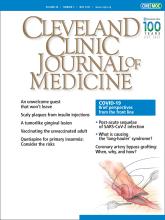ABSTRACT
An estimated 10% of COVID-19 survivors continue to experience symptoms several weeks to months after the appearance of initial symptoms, a condition termed post-acute sequelae of SARS-CoV-2 infection (PASC). These patients, also called “long-haulers,” most commonly report protracted symptoms of fatigue, cough, dyspnea, chest tightness, difficulty concentrating, arthralgia, olfactory dysfunction, and headache. While age, comorbid medical conditions, and COVID-19 severity are risk factors, young and previously healthy individuals with mild COVID-19 are also at risk. Recognition of symptoms, evaluation, supportive treatment, and attention to medical comorbidities are the cornerstones of medical management.
- Copyright © 2021 The Cleveland Clinic Foundation. All Rights Reserved.
- Susan Vehar, MD⇑
- Department of Critical Care Medicine; Department of Pulmonary Medicine; Cleveland Clinic, Cleveland, OH
- Address:
Susan Vehar, MD, A90, Cleveland Clinic, 9500 Euclid Avenue, Cleveland, OH 44195; vehars{at}ccf.org
- Prince Ntiamoah, MD
- Michelle Biehl, MD, MS
ABSTRACT
An estimated 10% of COVID-19 survivors continue to experience symptoms several weeks to months after the appearance of initial symptoms, a condition termed post-acute sequelae of SARS-CoV-2 infection (PASC). These patients, also called “long-haulers,” most commonly report protracted symptoms of fatigue, cough, dyspnea, chest tightness, difficulty concentrating, arthralgia, olfactory dysfunction, and headache. While age, comorbid medical conditions, and COVID-19 severity are risk factors, young and previously healthy individuals with mild COVID-19 are also at risk. Recognition of symptoms, evaluation, supportive treatment, and attention to medical comorbidities are the cornerstones of medical management.
- Copyright © 2021 The Cleveland Clinic Foundation. All Rights Reserved.






